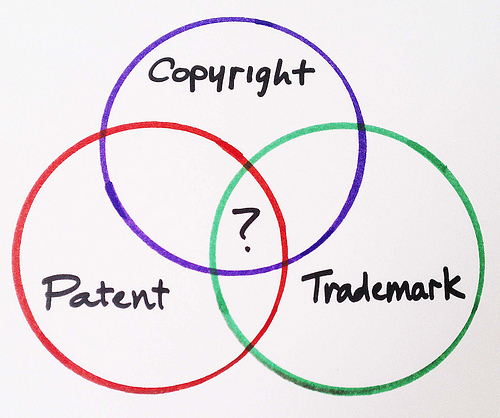Main forms of intellectual property protection available to companies
 Main forms of intellectual property protection available to companies include patents, trademarks, design copyright and trade secrets and important aspects of using these intellectual property protection techniques are discussed further below:
Main forms of intellectual property protection available to companies include patents, trademarks, design copyright and trade secrets and important aspects of using these intellectual property protection techniques are discussed further below:
Patenting is one of the most popular forms of intellectual property protection. Types of intellectual properties to be protected by patents relate to methods and processes that facilitate working of things (Davies and Cheng, 2011).
Patents can be divided into two categories: utility patents and design patents and patents have been initially developed in order to assist inventors to recoup research and development expenses before competitors with the same products enter the market.
Patent litigation issues are commonplace between multinational companies in general, and businesses in computing, consumer electronics and software industries in particular. For example, during the year of 2012 alone HTC, Taiwan-based global smartphone designer and manufacturer have been involved in ten patent litigation lawsuits (Annual Report, 2012).
The importance of protection of intellectual property is duly understood by many multinational companies. For example, Pepsico publicly announces that “we protect our intellectual property rights globally through a combination of trademark, copyright, patent and trade secret laws, third-party assignment and non-disclosure agreements” (Annual Report, 2012, p.47).
Moreover, one of the most recent cases of patent infringement lawsuit involve long-standing dispute between two global computer and consumer electronics manufacturing companies – Apple and Samsung. The dispute relates to Samsung’s use of technology that has been previously used by Apple for its IPhone and IPad products and patented. According to the verdict issued by a US Federal jury, Samsung Electronics has been ordered to pay Apple USD 290 million compensation (Martin, 2013).
Implications of this particular lawsuit are significant at the global scale, because it illustrates severe negative financial and brand image damage implications of patent violation practices.
Trademarks represent another form of intellectual property protection and they relate to symbol, design or logo that identifies a specific business or a product. Registration of trademarks is possible only after their use for a specific period of times. Trademarks are important elements of brand entity and famous trademarks such as Apple, Google, and McDonald’s worth billions of pounds.
Recent trademark disputes involve the case of Twitter vs. Twittad in October 2011, when popular social networking website Twitter faced with challenges in its attempts to register the term of ‘Tweet’ as a trademark due to previously registered trademark of ‘Let Your Ad Meet Tweets’ be Twittad (Solis, 2010). The dispute has been solved with Twittad transferring its above mentioned trademark phrase to Twitter for undisclosed amount of money.
According to the UK Intellectual Property Office copyright “protects written, theatrical, musical and artistic works as well as film, book layouts, sound recordings, and broadcasts” (IPO, online, 2014). A major difference of copyright compared to other forms of intellectual property protection relates to the fact that copyright is an automatic right, and there is no need to apply for it.
Internet and internet-related technologies have created major challenges for copyright protection. According to Tschmuck (2012) major Bit-Torrent trackers such as Mininova, Lime Wire and The Pirate Bay have been sued by a number of major media companies for providing platform and facilitating share of copyrighted materials in an illegal way.
The challenge of copyright violation through illegally downloading copyrighted content via Torrents and effective solutions are yet to be found to deal with this challenge.
Relatively recent case of copyright lawsuit involves street artist Shephard Fairley and Associated Press media agency, where Fairley used a photo of US President Barack Obama taken by Associated Press to create his famous ‘hope’ artwork (Turow, 2010). Lawsuit infringement charges initiated by Associated Press were sorted out of court; nevertheless, this case study clearly illustrates importance of the issue of copyright.
Trade secrets include ingredients, recipes, codes etc. and including relevant information in the contract of employment is the only method of their protection. Trade secrets are perceived to be closely associated with competitive advantage of businesses.
The secret ingredient of a famous soft drink – Coca-Cola that ensures it unique taste marks a good example for a trade secret. Additional examples of trade secrets can be mentioned as the formula of Listerine antiseptic liquid compound and McDonald’s Big Mac special sauce recipe.
References
Annual Report (2012) HTC
Annual Report (2012) Pepsico
Davies, C. & Cheng, T. (2011) “Intellectual Property Law in the United Kingdom” Kluwer Law International
Solis, B. (2010) “Engage: The Complete Guide for Brands and Businesses to Build, Cultivate and Measure Success in the New Web” John Wiley & Sons
Martin, S. (2013) “Apple gets $290m in Ssamsung Patent Dispute” USA Today
Tschmuck, P. (2012) “Creativity and Innovation in the Music Industry” 2nd edition, Springer Group
Turow, J. (2010) “Media Today: An Introduction to Mass Communication” Taylor & Francis
What is copyright? (2014) Intellectual Property Office, Available at: http://www.ipo.gov.uk/types/copy.htm
